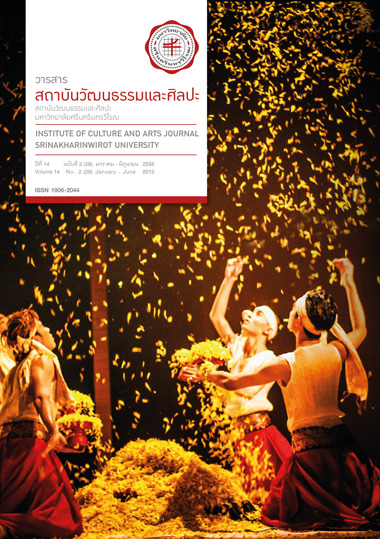ปัจจัยเชิงเหตุทางจิตและสังคมที่เกี่ยวข้องกับพฤติกรรมใฝ่รู้ใฝ่ดีของนักศึกษา ระดับปริญญาตรี THE PSYCHO-SOCIAL CORRELATES OF ACADEMIC AND VIRTUE ORIENTED BEHAVIORS OF UNDERGRADUATE STUDENTS*
บทคัดย่อ
บทคัดย่อ
การวิจัยครั้งนี้เป็นการวิจัยประเภทศึกษาความสัมพันธ์เปรียบเทียบ (Correlational-Comparative Study) มีจุดมุ่งหมายเพื่อศึกษาว่าปัจจัยเชิงเหตุด้านลักษณะสถานการณ์ จิตลักษณะเดิม และจิตลักษณะตามสถานการณ์ของนักศึกษา มีความเกี่ยวข้องกับพฤติกรรมใฝ่รู้ใฝ่ดีมากน้อยเพียงใดและเพราะเหตุใด กลุ่มตัวอย่างในครั้งนี้ ได้แก่ นักศึกษาในระดับปริญญาตรีชั้นปีที่ 2 ชั้นปีที่ 3 และชั้นปีที่ 4 ซึ่งศึกษาอยู่ในสาขาการผลิตสื่อดิจิตอล แอนิเมชั่น มัลติมีเดียและเกมส์ ในภาคเรียนที่ 1 ปีการศึกษา 2555 จำนวนทั้งสิ้น 424 คน ใช้รูปแบบทฤษฎีปฏิสัมพันธ์นิยมเพื่อกำหนดตัวแปรเชิงสาเหตุ และใช้สถิติการถดถอยพหุคูณแบบมีลำดับ ผลการวิจัยพบว่า ตัวแปรทั้ง 10 ตัว สามารถทำนายพฤติกรรมใฝ่รู้ใฝ่ดีรายด้านทั้งในกลุ่มรวมและกลุ่มย่อยได้ดังนี้ 1) ทำนายพฤติกรรมการยอมรับนวัตกรรมด้านวิชาการ ชุดตัวทำนายลำดับที่ 1 สามารถทำนายได้ระหว่างร้อยละ 6.3 ถึงร้อยละ 37.9 ทำนายได้สูงสุดในกลุ่มนักศึกษาที่เคยเข้ารับการอบรมเสริมความรู้และทักษะ พบตัวทำนายที่สำคัญ คือ การเห็นแบบอย่างจากสื่อมวลชน และการมีแบบอย่างที่ดีจากผู้ปกครอง ตามลำดับ และเมื่อนำชุดตัวทำนายลำดับที่ 2 เข้าร่วมสามารถทำนายได้เพิ่มขึ้นอย่างมีนัยสำคัญในกลุ่มรวมและในทุกกลุ่มย่อย โดยเพิ่มขึ้นระหว่างร้อยละ 5.8 ถึง ร้อยละ 21.8 ทำนายได้สูงสุดในกลุ่มนักศึกษาชั้นปีที่ 3 มีตัวทำนายที่สำคัญ คือ การเห็นแบบอย่างจากสื่อมวลชน ความชอบเสี่ยงน้อย และลักษณะมุ่งอนาคต-การควบคุมตน ตามลำดับ และเมื่อนำชุดตัวทำนายลำดับที่ 3 เข้าร่วมทำนาย สามารถทำนายได้เพิ่มขึ้นอย่างมีนัยสำคัญ ในกลุ่มรวมและในกลุ่มย่อย โดยทำนายได้เพิ่มขึ้นอยู่ระหว่างร้อยละ 6.4 ถึง ร้อยละ 19.2 ทำนายได้เพิ่มขึ้นสูงสุดในกลุ่มนักศึกษาที่มี ผลการเรียนต่ำ มีตัวทำนายที่สำคัญ คือ การมีเจตคติที่ดีต่อพฤติกรรมใฝ่รู้ใฝ่ดี สติสัมปชัญญะ แรงจูงใจใฝ่สัมฤทธิ์ ลักษณะ มุ่งอนาคต-การควบคุมตน และความชอบเสี่ยงน้อย ตามลำดับ 2) ทำนายพฤติกรรมการใช้เทคโนโลยีอย่างเหมาะสม ชุดตัวทำนายลำดับที่ 1 สามารถทำนายได้ระหว่างร้อยละ 7.8 ถึงร้อยละ 35.2 และทำนายได้สูงสุดในกลุ่มนักศึกษาที่เคยเข้ารับการอบรมเสริมความรู้และทักษะ โดยการมีแบบอย่างที่ดีจากผู้ปกครอง เป็นตัวทำนายที่สำคัญ และเมื่อนำชุดตัวทำนายลำดับที่ 2 เข้าร่วมทำนาย สามารถทำนายได้เพิ่มขึ้นอย่างมีนัยสำคัญในกลุ่มรวมและในทุกกลุ่มย่อย โดยเพิ่มขึ้นระหว่างร้อยละ 8.8 ถึงร้อยละ 40.2 ทำนายได้เพิ่มขึ้นสูงสุดในกลุ่มนักศึกษาที่มีประสบการณ์เข้ารับการอบรมเสริมความรู้และทักษะ มีตัวทำนายที่สำคัญ คือสติสัมปชัญญะ และลักษณะมุ่งอนาคต-การควบคุมตน ตามลำดับ เมื่อนำชุดตัวทำนายลำดับที่ 3 เข้าร่วมทำนายสามารถทำนายได้เพิ่มขึ้นอย่างมีนัยสำคัญในกลุ่มรวมและกลุ่มย่อย เพิ่มขึ้นอยู่ระหว่างร้อยละ 1.6 ถึง ร้อยละ 7.9 ทำนายได้เพิ่มขึ้นสูงสุดในกลุ่มนักศึกษาชาย มีตัวทำนายที่สำคัญ คือ ความชอบเสี่ยงน้อย การมีแบบอย่างที่ดีจากผู้ปกครอง สติสัมปชัญญะ และการรับรู้คุณความดี ตามลำดับสนับสนุนเพื่อนให้ใฝ่รู้ใฝ่ดี ชุดตัวทำนายลำดับที่ 1 สามารถทำนายได้ระหว่างร้อยละ 12.0 ถึงร้อยละ 57.2 ทำนายได้สูงสุดในกลุ่มนักศึกษาที่เคยเข้ารับการอบรมเสริมความรู้และทักษะ มีตัวทำนายที่สำคัญ คือ การเห็นแบบอย่างจากสื่อมวลชน และการมีแบบอย่างที่ดีจากผู้ปกครอง ตามลำดับ และเมื่อนำชุดตัวทำนายลำดับที่ 2 เข้าร่วมทำนาย สามารถทำนายได้เพิ่มขึ้นอยู่ระหว่างร้อยละ 6.5 ถึง ร้อยละ 20.6 และทำนายได้เพิ่มขึ้นสูงสุดในกลุ่มนักศึกษาเพศชาย มีตัวทำนายที่สำคัญ คือ แรงจูงใจใฝ่สัมฤทธิ์ ความชอบเสี่ยงน้อย การเห็นแบบอย่างจากสื่อมวลชน และลักษณะมุ่งอนาคต-การควบคุมตน ตามลำดับ และตัวทำนายลำดับที่ 3 เข้าร่วมทำนาย สามารถทำนายได้เพิ่มขึ้นอยู่ระหว่างร้อยละ 4.4 ถึง ร้อยละ 13.8 ทำนายได้เพิ่มขึ้นสูงสุดในกลุ่มนักศึกษาชั้นปีที่ 3 มีตัวทำนายที่สำคัญ คือ การเห็นแบบอย่างจากสื่อมวลชน การมีเจตคติที่ดีต่อพฤติกรรมใฝ่รู้ใฝ่ดี ความชอบเสี่ยงน้อย และการรับรู้คุณความดี ตามลำดับ ผลส่วนนี้สนับสนุนสมมติฐานที่กำหนดขึ้นบนพื้นฐานของรูปแบบทฤษฏีปฏิสัมพันธ์นิยม
คำสำคัญ : ใฝ่รู้ใฝ่ดี, การยอมรับนวัตกรรมด้านวิชาการ, การใช้เทคโนโลยีอย่างเหมาะสม, สนับสนุนเพื่อน
Abstract
This Correlational-Comparative study was contained the objectives of the examinations which comparing the relationship between student’s learning perception with psychological traits and psychological states. There was 424 students be the main focus group which was not only junior but also sophomore and senior college students from the major of digital media production, animation, multimedia and games. Based on the Interactionism Model as a conceptual Framework, there was 10 variables. 1) the predictative of the innovative behavior from the first predictive variables stated that 6.3% to 37.9% were the students who had a specific knowledge and skill training experiences. In the order of mass media modeling and appropriated parental modeling were found as an important predictive variable. After using the second predictive variable were over-control the first predictive variable to make it more stable, the prediction was rising up to 5.8% to 21.8% which the highest predictation was 21.8%. From sophormore students had beed found an important predictation which were mass meadia modeling, less amount of risk preference and future orientation and self control, by odered. Once using the third predictive variable over-control the first and second ones, the predictation was highly rising in most of sample and 6 groups of 11 groups. The predictive variable was rising up to 6.4% to 19.2% which the highest predicted was from the students who had a lower scored and the important predictation was the favorable attitude toward academic and virtue behaviors, mindfulness, need for achievement, future orientation and self control and less amount of risk preference, by ordered; 2) the predictative of the appropriate use of technology from the first predictive variable stated that 7.8% to 35.2% were the students who had specific knowledge and skill training experiences and having the appropriate parental modeling as an important predictive variable. After taking the second predictive variable over controled the first predictive variable to make it stable, it was rising the predictation in most of every sample to 8.8% to 40.2%. The highest predictation was from specific knowledge and skill training experiences by having mindfulness and future orientation and self control as the important predictation, by ordered. Once using the third predictive variable over-control the first and second ones, the predictation was highly rising in most of sample and 9 groups of 11 groups. The predictive variable was rising up to 1.6% to 7.9% which the highest predicted was from the male students who and the important predictation was less amount of risk preference, appropriate parental modeling, mindfulness and attitudinal gratefulness, by ordered; 3) the predictative of the peer enhancement on academic and virtue behaviors behavior from the first predictive variables stated that 12.0% to 57.2% were the students who had a specific knowledge and skill training experiences. In the order of mass media modeling and appropriated parental modeling were found as an important predictive variable. After using the second predictive variable were over-control the first predictive variable to make it more stable, the prediction was rising up to 6.5% to 20.6% which the highest predictation was from male students which had beed found need for achievement, less amount of risk preference, mass media modeling and future orientation and self control, by odered. Once using the third predictive variable over-control the first and second ones, the predictation was highly rising in most of sample and 6 groups of 11 groups. The predictive variable was rising up to 4.4% to 13.8% which the higest predicted was from the sophomore students and the important predictation was the mass media modeling, favorable attitude toward academic and virtue oriented behaviors, less amount of risk preference and Attitudinal gratefulness, by ordered and supported the interactionism model.
Keywords: Academic and Virtue Oriented, Innovative, Appropriate use of Technology, Peer enhancement
*งานวิจัยนี้ได้รับทุนการวิจัยจากบัณฑิตวิทยาลัย มหาวิทยาลัยศรีนครินทรวิโรฒ งบประมาณเงินแผ่นดินประจำปีการศึกษา 2555
Downloads
ดาวน์โหลด
รูปแบบการอ้างอิง
ฉบับ
ประเภทบทความ
สัญญาอนุญาต
บทความทุกบทความที่ได้รับการตีพิมพ์ถือเป็นลิขสิทธิ์ของวารสารสถาบันวัฒนธรรมและศิลปะ มหาวิทยาลัยศรีนครินทรวิโรฒ



